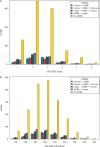Characteristics of patients with atrial high rate episodes detected by implanted defibrillator and resynchronization devices
- PMID: 34426836
- PMCID: PMC8892042
- DOI: 10.1093/europace/euab186
Characteristics of patients with atrial high rate episodes detected by implanted defibrillator and resynchronization devices
Abstract
Aims: Atrial high rate episodes (AHREs) are associated with increased risks of thromboembolism and cardiovascular mortality. However, the clinical characteristics of patients developing AHRE of various durations are not well studied.
Methods and results: This was an ancillary analysis of the multicentre, randomized IMPACT trial. In the present analysis, we classified patients according to the duration of AHRE ≤6 min, >6 min to ≤6 h, >6 to ≤24 h and >24 h, and investigated the association between clinical factors and the development of each duration of AHRE. Of 2718 patients included in the trial, 945 (34.8%) developed AHRE. The incidence rates of each AHRE duration category were 5.4/100, 12.0/100, 6.8/100, and 3.3/100 patient-years, respectively. The incidence rates of AHRE >6 h were significantly higher in patients at high risk of thromboembolism (CHADS2 score ≥3) compared to those at low risk (CHADS2 score 1 or 2). Using Cox regression analysis, age ≥65 years and history of atrial fibrillation (AF) and/or atrial flutter (AFL) were risk factors for AHRE >6 min. In addition, hypertension was associated with AHRE >24 h (hazard ratio 2.13, 95% confidence interval 1.24-3.65, P = 0.006).
Conclusion: Atrial high rate episode >6 min to ≤6 h were most prevalent among all AHRE duration categories. Longer AHREs were more common in patients at risk of thromboembolism. Age and history of AF/AFL were risk factors for AHRE >6 min. Furthermore, hypertension showed a strong impact on the development of AHRE >24 h rather than age.
Keywords: Atrial fibrillation; Atrial high rate episode; Cardiac implantable electronic device; Clinical profile; Stroke; Thromboembolism.
© The Author(s) 2021. Published by Oxford University Press on behalf of the European Society of Cardiology.
Figures




Comment in
-
Characteristics of patients with atrial high rate episodes detected by implanted defibrillator and resynchronization devices: Editorial comment.Europace. 2022 Mar 2;24(3):353-354. doi: 10.1093/europace/euab242. Europace. 2022. PMID: 34741616 No abstract available.
References
-
- Vermond RA, Geelhoed B, Verweij N, Tieleman RG, Van der Harst P, Hillege HL. et al. Incidence of atrial fibrillation and relationship with cardiovascular events, heart failure, and mortality: a community-based study from the Netherlands. J Am Coll Cardiol 2015;66:1000–7. - PubMed
-
- Gladstone DJ, Spring M, Dorian P, Panzov V, Thorpe KE, Hall J. et al. Atrial fibrillation in patients with cryptogenic stroke. N Engl J Med 2014;370:2467–77. - PubMed
-
- Grau AJ, Weimar C, Buggle F, Heinrich A, Goertler M, Neumaier S. et al. Risk factors, outcome, and treatment in subtypes of ischemic stroke: the German Stroke Data Bank. Stroke 2001;32:2559–66. - PubMed
-
- Healey JS, Connolly SJ, Gold MR, Israel CW, Van Gelder IC, Capucci A. et al. Subclinical atrial fibrillation and the risk of stroke. N Engl J Med 2012;366:120–9. - PubMed
-
- Freedman B, Boriani G, Glotzer TV, Healey JS, Kirchhof P, Potpara TS.. Management of atrial high-rate episodes detected by cardiac implanted electronic devices. Nat Rev Cardiol 17;14:701–14. - PubMed
Publication types
MeSH terms
LinkOut - more resources
Full Text Sources
Medical

